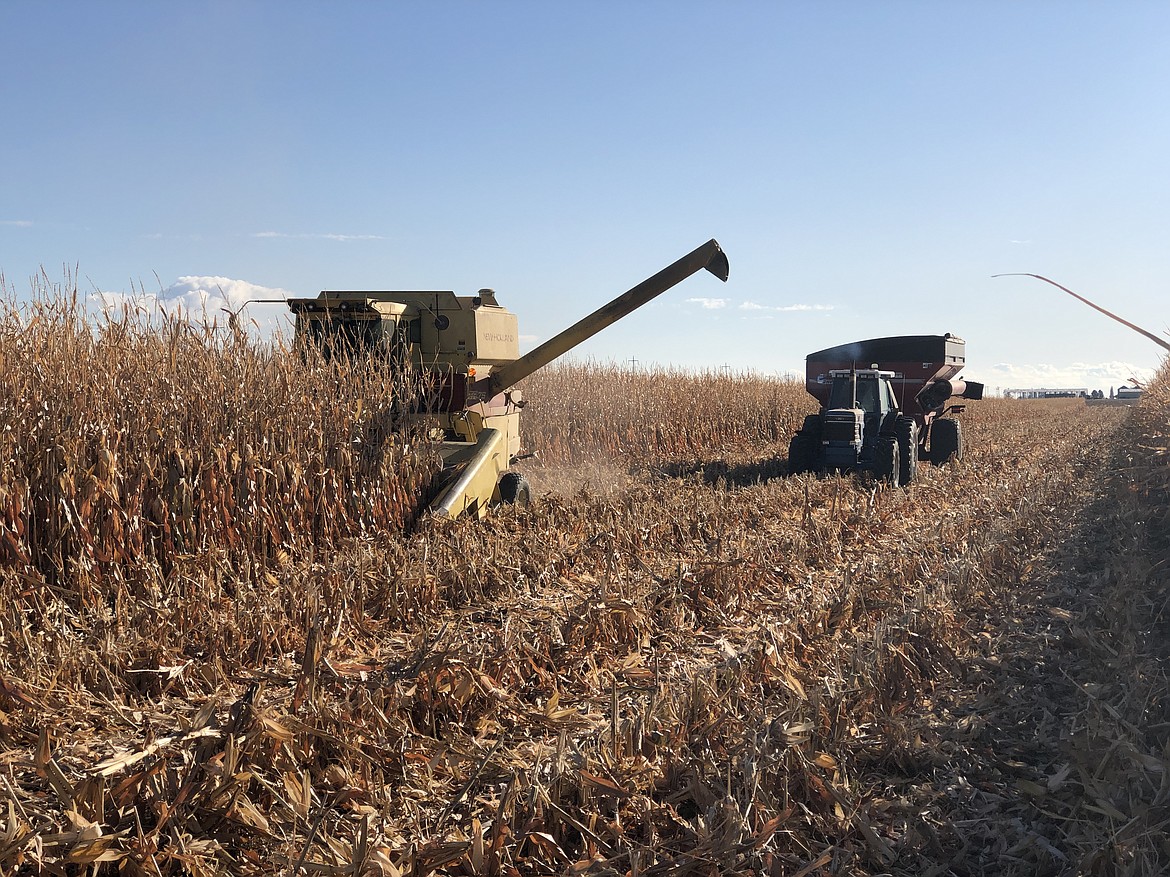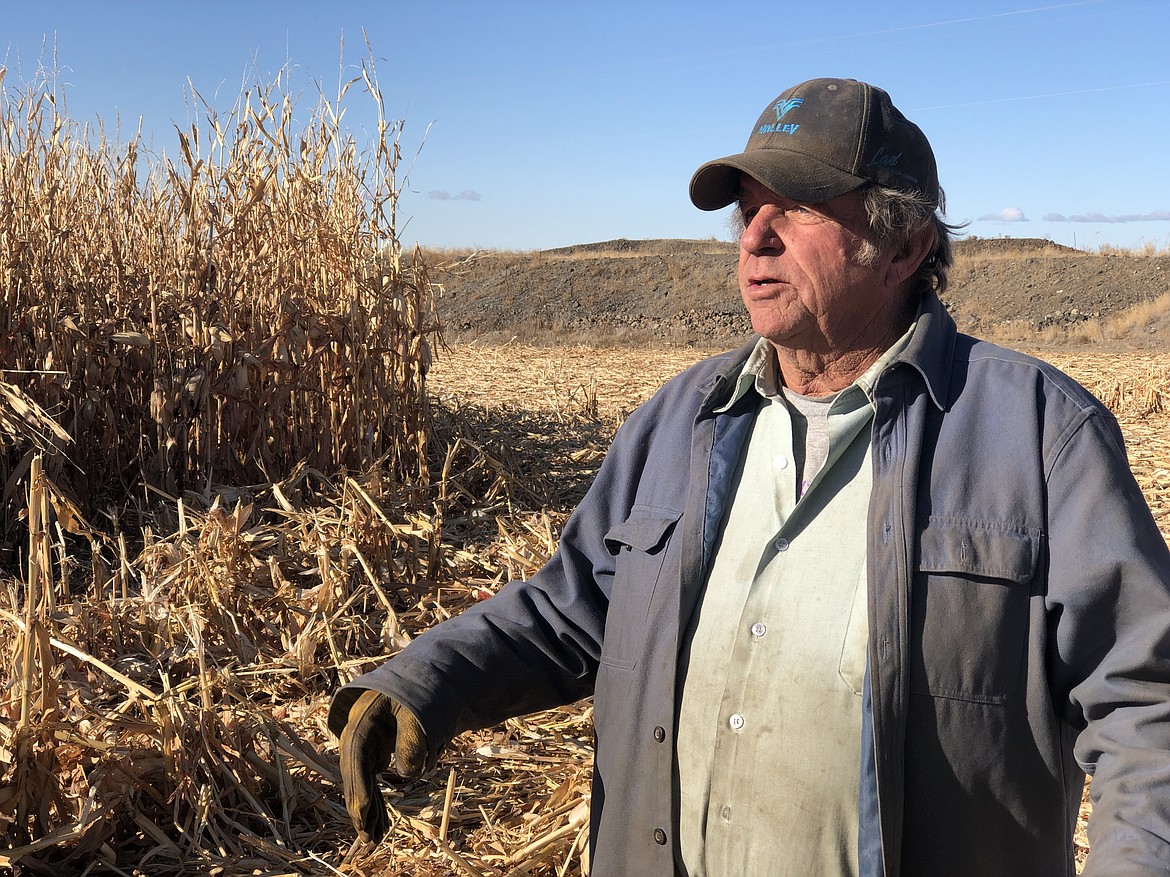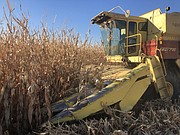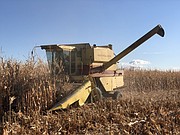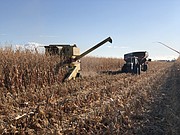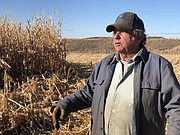Farmer breathes new life into an old combine
STRATFORD — It all started when Dan Hendrickson decided to plant something other than hay this year.
“I put some corn in because the alfalfa and timothy hay market was not good, and I’d not done that in about 18 years,” he said.
Hendrickson was standing amid the stubble of about 130 acres of that corn on the northwest corner of Stratford Road and Road 16. Most of it has been harvested, and if things went as planned, Hendrickson said he and his sons Quinton and Preston would be finished by the end of Wednesday, Nov. 11, just before cold, rainy weather was expected to hit the Columbia Basin.
“It’s really good corn,” he said, cobs stripped of kernels and stubble crunching underneath his feet. “And this’ll all add to the soil.”
It’s slow going, the harvesting. And it wouldn’t be anything remarkable except for the combine crawling through the field at a glacial 1 mph. It’s a 1980 New Holland TR75 that, not so long ago, was quietly rusting away, sitting in a corner of Hendrickson’s farm, partly obscured by tall weeds, home to assorted birds and vermin, filled with feathers and droppings and whatnot.
“The combine last cut wheat about 15 years ago, and then it sat there for 15 years. It didn’t do anything,” Hendrickson said.
Originally, getting the old combine up and running was an experiment, something Hendrickson said he and his sons did simply to see if they could do it.
“It was sitting there in the weeds, junk all over the place. If we were ever going to go after that thing, if we were ever going to try it, it would be now or never,” Hendrickson said. “Because if you let it go any further, you might not be able to save it.”
But Hendrickson wanted to be careful. If the project was going to cost too much, if the old combine threatened to become a “barrel without bottom” and required too much money to get going, well, it would have to remain a decaying wreck amid the weeds.
There was no hard-and-fast limit to what they were willing to spend to get the old machine going, Hendrickson said. Just a vague sense that some amount, at some point, would be too much.
“We were always ready to pull the plug if it got too expensive,” he explained. “We don’t want to put any more into it than we had to.”
They trudged into the field, put a new battery in the old combine, checked to see that it still had fuel and oil and antifreeze, whether there was air still in the tires, and then Hendrickson said one of his sons climbed into the cab and tried to turn the engine over.
“It started right up,” he said. “It’s amazing what still worked on that thing.”
While there was the mess made by 15 years of things living inside it that needed to be cleaned up, all of the wiring was still intact, Hendrickson said. Over the course of a few weeks, they tinkered with things. They replaced the wheat header with a corn header Hendrickson had sitting around, and then stripped the innards – the sieves and the rollers – needed to properly harvest corn from several defunct New Holland combines belonging to Hendrickson’s brother.
Along the way, Hendrickson said he watched a few videos on the internet and even sought out assistance and tips from another farmer or two on getting the combine up and running, and to remind himself on how to swap out wheat parts for corn parts. It also took some time, and some firm, but gentle, work to get things like the auger to deploy.
“We worked it back and forth, and finally it did,” said J.J., a friend of Hendrickson who has been helping on the farm. “Kind of like the Tin Woodman from ‘Wizard of Oz,’ but we had the time.”
It took six weeks to get the TR75 up and running, with little things like bearings, cylinders and chains breaking or freezing up almost daily and needing to be greased, worked or replaced. As the corn ripened under the summer sun, they tinkered, with Hendrickson thinking they’d play a little bit with the old combine come harvest time, maybe see how it worked around the edges.
“We never saw a reason why we shouldn’t work on it,” he said.
After all, the Hendricksons had already contracted with someone to harvest their corn for them. For $10,000.
“But I didn’t hear from that custom guy, and it turns out he was having trouble with his combine,” Hendrickson said. “It had some major problems … it was a big to-do. On top of that, his corn went down. He had his own problems to worry about.”
Suddenly, all the work on the New Holland TR75 became necessary.
“So, what came from just a poking around, might just do some of the edges stuff and have a little fun became a full-fledged deal that had to do the whole works,” he said.
And it has worked. The grain is clean, and almost none is wasted in the field, Hendrickson said.
“We put about $2,000 into it,” he added, noting that it was last valued at “not worth nothing” by a professional auctioneer.
The same model and similar year New Holland combines are reported on the internet to have sold at auction for around $500. So, not quite nothing.
Hendrickson attributes the machine’s “resurrection” to divine intervention more than he does his mechanical skills.
“A lot of this is not just natural,” he said as the combine, driven by one of his sons, turned to cut another swath through the corn. “It just isn’t natural that this stuff should run like it does.”
Charles H. Featherstone can be reached at [email protected]





